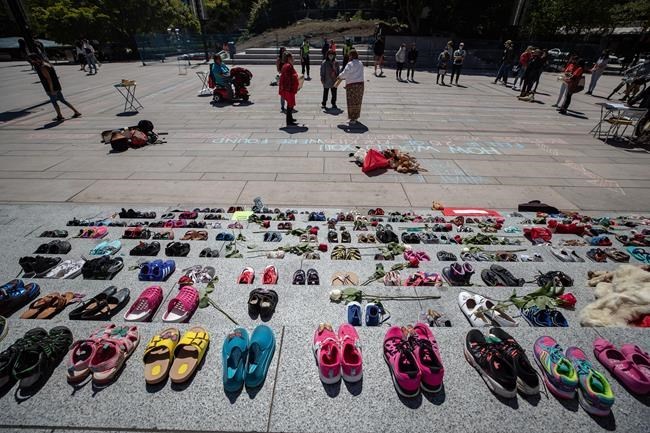VANCOUVER — Officials in Vancouver said they plan to meet with the artist and volunteers who are keeping vigil on a children's shoe memorial on the steps of the city's art gallery in an effort to end the tribute to children who didn't return from residential schools.
The city said in a statement on Friday that it notified the artist in November that the growing memorial needed to come down ahead of the two-year anniversary of the announcement of the Kamloops discovery this May.
It said the decision is supported by the local Musqueam, Squamish and Tsleil-Waututh nations.
"The City acknowledges there is still a need for healing and mourning spaces," the statement said. "While the temporary memorial cannot remain on the steps of the Vancouver Art Gallery, the City will continue to work with (Musqueam, Squamish and Tsleil-Waututh) Nations and Urban Indigenous communities to create a more permanent and culturally appropriate memorial."
In the meantime, the city said it will work with the artists of the temporary memorial to "identify interim spaces" for healing and vigils.
The installation started with 215 pairs of children's shoes on the gallery steps and was set up shortly after the Tk'emlups te Secwepemc First Nation announced the discovery of suspected unmarked graves of children on the grounds of the Kamloops Indian Residential School.
Today, the site sits behind metal barriers separating pedestrians from the gallery steps, creating space for a teepee, a tent housing the artists guarding the memorial, several posters decrying "genocide," a small collection of orange shirts and a large arrangement of shoes and teddy bears covering 17 rows of the steps.
Mayor Ken Sim said city officials "want to deal with it in a very respectful way, with input from Musqueam, Squamish and Tsleil-Waututh."
“It’s a very sensitive topic,” he said Friday during an unrelated news conference. “The last thing we want to do is have a knee-jerk reaction that could be construed as insensitive by some communities.”
The city said the memorial was initially installed in response to the profound need for grieving and healing spaces, but the continuation of the memorial is not aligned with the spiritual practices of the three area First Nations.
The city said it should have acted sooner to bring the memorial to a close once it realized the local nations were not consulted and had not given permission for the installation.
The statement said the teachings handed down through generations for the Musqueam, Squamish and Tsleil-Waututh nations say that "as long as the memorial remains, the spirits of the children will remain tethered to the items placed on the steps and cannot move on."
This report by The Canadian Press was first published March 31, 2023.
The Canadian Press



